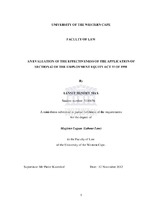| dc.description.abstract | This paper evaluates s 42 of the South African Employment Equity Act (EEA) with specific focus on the application of the demographic profile of the national and regional economically active population by designated employers. The comparative analysis considers how the law of affirmative action in the United States of America and in Namibia, international conventions and the International Labour Organization (ILO) in relation to South Africa’s Constitution and the EEA promote affirmative action. While international law holds that affirmative action measures should be of a temporary nature with an individualistic focus on formal equity, the EEA granted affirmative action measures which are permanent, group based and substantive in nature.Given South Africa`s discriminatory past, it became an accepted principle that affirmative action needs to be implemented to redress the imbalances caused by apartheid. In broad terms, the EEA provides for the advantage of persons or certain categories of persons who were disadvantaged by unfair discrimination. As a result the EEA focuses on race, sex and people with disabilities to determine those who are to be the beneficiaries of affirmative action. International Law also embraces the notion of affirmative action and place a duty on all member states to act pro-actively to correct the effects of unfair discrimination. The mini-thesis also evaluates the powers of the Director-General of Labour with specific focus on the enforcement of measures and how it relates to the Promotion of Administrative Justice Act (PAJA) in compliance with the provisions of the EEA. It is concluded that s 42 of the EEA (with the exception of s 42(a)(i)) provides sufficient measures to redress the inequalities of the past by providing equal opportunities for suitably qualified people of the designated groups. That the Constitution and the EEA does not provide for differentiation amongst “Black people” (African, Coloureds and Indians). That the application of both the national and regional demographics are compulsory in formulating an equity plan, that the one cannot be ignored in favour of the other, and that the Director-General of Labour is sufficiently empowered to ensure compliance with the provisions of the EEA. | en_US |

